Integrated Reservoir Characterization Study of the McKee Formation, Onshore Taranaki Basin, New Zealand
Abstract
:1. Introduction
2. Geological Setting and Lithostratigraphy
3. Materials and Methods
3.1. Sedimentological and Petrographical Analysis
3.2. Well Log Analysis
4. Results and Discussions
4.1. Sedimentological and Petrographical Study
4.1.1. Composition and Texture of McKee Sandstone
4.1.2. Depositional Control
4.1.3. Diagenetic Control
Dissolution
Clay Minerals
Cementation
Compaction
4.2. Core Sample Analysis
4.3. Well Log Analysis
4.3.1. Shale Distribution and Water Saturation Equation
4.3.2. Qualitative Interpretation
4.3.3. Quantitative Interpretation
5. Conclusions
Acknowledgments
Author Contributions
Conflicts of Interest
References
- King, P.; Thrasher, G. Description and Depositional History of Cretaceous and Cenozoic Sedimentary Rocks. In Cretaceous-Cenozoic Geology and Petroleum Systems of the Taranaki Basin, New Zealand; Sherwood, A., Ed.; Institute of Geological & Nuclear Sciences Limited: Lower Hutt, New Zealand, 1996; ISBN 0-478-09512-0. [Google Scholar]
- Palmer, J. Pre-Miocene lithostragraphy of Taranaki Basin, New Zealand. N. Z. J. Geol. Geophys. 1985, 28, 197–216. [Google Scholar] [CrossRef]
- Molenaar, N.; Felder, M.; Bär, K.; Götz, A.E. What classic greywacke (litharenite) can reveal about feldspar diagenesis: An example from Permian Rotliegend sandstones in Hessen, Germany. Sediment. Geol. 2015, 326, 79–93. [Google Scholar] [CrossRef]
- Aretz, A.; Bär, K.; Götz, A.E.; Sass, I. Outcrop analogue study of Permocarboniferous geothermal sandstone reservoir formations (northern Upper Rhine Graben): Impact of mineral content, depositional environment and diagenesis on petrophysical properties. Int. J. Earth Sci. 2015, 105, 1431–1452. [Google Scholar] [CrossRef]
- Shalaby, M.R.; Hakimi, M.H.; Abdullah, W.H. Diagenesis in the Middle Jurrasic Khatatba Formation sandstones in the Shoushan Basin, northern Western Desert, Egypt. Geol. J. 2014, 49, 239–255. [Google Scholar] [CrossRef]
- Bjørlykke, K.; Ramm, M.; Saigal, G.C. Sandstone diagenesis and porosity modification during basin evolution. Geol. Rundsch. 1989, 78, 243–268. [Google Scholar] [CrossRef]
- Webster, M.; O’Connor, S.; Pindar, B.; Swarbrick, R. Overpressures in the Taranaki Basin: Distribution, causes, and implications for exploration. AAPG Bull. 2011, 95, 339–370. [Google Scholar] [CrossRef]
- Pilaar, W.; Wakefield, L. Hydrocarbon Generation in the Taranaki Basin, New Zealand. In Petroleum Geochemistry and Basin Evaluation; Demaison, G., Murris, R.J., Eds.; AAPG Memoir: Tulsa, OK, USA, 1984; Volume 35, pp. 405–423. ISBN Electronic 9781629811574. [Google Scholar]
- Uruski, C.; Baillie, P. Petroleum Potential of New Zealand’s Deepwater Basins. In Proceedings of the PESA Eastern Australasian Basins Symposium, Melbourne, Australia, 25–28 November 2001; pp. 151–158. [Google Scholar]
- King, P.R.; Funnell, R.H. Petroleum systems of the Taranaki Basin, New Zealand: A Review. In Proceedings of the Petroleum Systems of SE Asia and Australasia Conference, Jakarta, Indonesia, 23–27 May 1997; pp. 155–170. [Google Scholar]
- Higgs, K.E.; King, P.R.; Raine, J.I.; Sykes, R.; Browne, G.H.; Crouch, E.M.; Baur, J.R. Sequence stratigraphy and controls on reservoir sandstone distribution in an Eocene marginal marine-coastal plain fairway, Taranaki Basin, New Zealand. Mar. Pet. Geol. 2012, 32, 110–137. [Google Scholar] [CrossRef]
- Bulte, G. Styles of Compressional Wrench Faulting Taranaki Basin, New Zealand. Proc. South East Asia Pet. Explor. Soc. 1988, 8, 80–91. [Google Scholar]
- Reilly, C.; Nicol, A.; Walsh, J.J.; Seebeck, H. Evolution of faulting and plate boundary deformation in the Southern Taranaki Basin, New Zealand. Tectonophysics 2015, 651, 1–18. [Google Scholar] [CrossRef]
- Haque, A.E.; Islam, M.A.; Shalaby, M.R. Structural Modeling of the Maui Gas Field, Taranaki Basin, New Zealand. Pet. Explor. Dev. 2016, 43, 965–975. [Google Scholar] [CrossRef]
- Knox, G.J. Taranaki Basin, structural style and tectonic setting. N. Z. J. Geol. Geophys. 1982, 25, 125–140. [Google Scholar] [CrossRef]
- Palmer, J.; Bulte, G. Taranaki Basin, New Zealand. In Active Margins Basins; Biddle, K.T., Ed.; AAPG Special Volumes; AAPG: Tulsa, OK, USA, 1988; Volume 52, pp. 261–282. ISBN 978-1-58861-433-9. [Google Scholar]
- Hills, K.C.; Hoffman, N.; Channon, G.; Courteney, S.; Kendrick, R.; Keetley, J.T. Structural styles and hydrocarbon traps in the onshore Taranaki Fold Belt, New Zealand. Pet. Explor. Soc. Aust. 2004, 2, 181–196. [Google Scholar]
- Smale, D.; Morton, A.C. Heavy mineral suites of core samples from the McKee Formation (Eocene-Lower Oligocene), Taranaki: Implications for provenance and diagenesis. N. Z. J. Geol. Geophys. 1987, 30, 299–306. [Google Scholar] [CrossRef]
- New Zealand Petroleum and Minerals. New Zealand Petroleum Basins; Ministry of Business, Innovation and Employment: Wellington, New Zealand, 2014. [Google Scholar]
- Mahmoud, M.; Ghorab, M.; Shazly, T.; Shibl, A.; Abuhagaza, A.A. Reservoir characterization utilizing the well logging analysis of Abu Madi Formation, Nile Delta, Egypt. Egypt. J. Pet. 2016, 26, 649–659. [Google Scholar] [CrossRef]
- Hussain, M.; Ahmed, N.; Chun, W.Y.; Khalid, P.; Mahmood, A.; Ahmad, S.R.; Rasool, U. Reservoir characterization of basal sand zone of lower Goru Formation by petrophysical studies of geophysical logs. J. Geol. Soc. India 2017, 89, 331–338. [Google Scholar] [CrossRef]
- Al-Areeq, N.M.; Alaug, A.S. Well log analysis and hydrocarbon potential of the Sa’ar–Nayfa reservoir, Hiswah Oilfield, eastern Yemen. Arabian J. Geosci. 2014, 7, 2941–2956. [Google Scholar] [CrossRef]
- Onovughe, E.; Sofolabo, A. Saturation Modelling: Using the Waxman-Smits model/equation in Saturation Determination in Dispersed Shaly sands. J. Multidiscip. Eng. Sci. Technol. 2016, 3, 4985–4992. [Google Scholar]
- Pettijohn, F.J.; Potter, P.E.; Siever, R. Introduction and Source Materials. In Sand and Sandstone, 2nd ed.; Springer: New York, NY, USA, 1987; pp. 1–21. ISBN 978-1-4612-1066-5. [Google Scholar]
- Jumat, N.; Shalaby, M.R.; Islam, M.A. Integrated reservoir characterization of the Paleocene Farewell, Taranaki Basin, New Zealand, using petrophysical and petrographical analyses. J. Pet. Explor. Prod. Technol. 2017, 1–17. [Google Scholar] [CrossRef]
- Nelson, P.H. Permeability-porosity relationships in sedimentary rocks. Log Anal. 1994, 35. Document ID: SPWLA-1994-v35n3a4. [Google Scholar]
- Schmidt, V.; McDonald, D.A. Texture and Recognition of Secondary Porosity in Sandstones. SEPM 1979, 26, 209–225. [Google Scholar]
- Al Areeq, N.M.; Soliman, M.A.; Essa, M.A.; Al-Azazi, N.A. Diagenesis and reservoir quality in the Lower Cretaceous Qishn sandstones from Masila oilfields in the Sayun-Masila Basin, eastern Yemen. Geol. J. 2016, 51, 405–420. [Google Scholar] [CrossRef]
- Loucks, R.G. Revisiting the importance of Secondary Dissolution Pores in Tertiary Sandstones Along the Texas Gulf Coast. Gulf Coast Assoc. Geol. Soc. Trans. 2005, 55, 447–455. [Google Scholar]
- Wilson, M.D.; Pittman, E.D. Authigenic clays in sandstones: Recognition and influence on reservoir properties and paleoenvironmental analysis. J. Sediment. Res. 1977, 47, 3–31. [Google Scholar]
- Worden, R.H.; Morad, S. The effect of oil emplacement on diagenetic clay mineralogy: The Upper Jurassic Magnus Sandstone Member, North Sea. In Clay Minerals in Sandstones: Controls on Formation, Distribution and Evolution; Worden, R.H., Morad, S., Eds.; Blackwell Publishing Ltd.: Hoboken, NJ, USA, 2003; Volume 34, pp. 453–469. ISBN 1-40510-587-9. [Google Scholar]
- Huang, W.L.; Bishop, A.M.; Brown, R.W. The effect of fluid/rock ratio on feldspar dissolution and illite formation under reservoir conditions. Clay Miner. 1986, 21, 585–601. [Google Scholar] [CrossRef]
- Nichols, G. Chapter 18: Post-depositional structures and diagenesis. In Sedimentology and Stratigraphy, 2nd ed.; WILEY-BLACKWELL: West Sussex, UK, 2009; pp. 274–296. ISBN 978-1-4051-3592-4. [Google Scholar]
- Hakimi, M.H.; Shalaby, M.R.; Abdullah, W.H. Diagenetic characteristics and reservoir quality of the Lower Cretaceous Biyadh sandstones at Kharir oilfield in the western central Masila Basin, Yemen. J. Asian Earth Sci. 2012, 51, 109–120. [Google Scholar] [CrossRef]
- Al-Ramadan, K.A.; Hussain, M.; Imam, B.; Saner, S. Lithologic characteristics and diagenesis of the Devonian Jauf sandstone at Ghawar Field, eastern Saudi Arabia. Mar. Pet. Geol. 2004, 2, 1221–1234. [Google Scholar] [CrossRef]
- Porter, E.W.; James, W.C. Influence of pressure, salinity, temperature and grain size on silica diagenesis in quartzose sandstones. Chem. Geol. 1986, 57, 359–369. [Google Scholar] [CrossRef]
- Schlumberger Wireline & Testing. Fundamentals of the Quantitative Log Interpretation. In Schlumberger-Log Interpretation Principles & Applications, 7th ed.; Schlumberger Wireline & Testing: Sugar Land, TX, USA, 1989; pp. 1–8. [Google Scholar]
- AL-Laboun, A.; AL-Quraishi, A.; Zaman, H.; Benaafi, M. Reservoir characterization of the Burqan Formation sandstone from Midyan Basin, northwestern Saudi Arabia. Turk. J. Earth Sci. 2014, 23, 204–214. [Google Scholar] [CrossRef]
- Hu, X.; Huang, S. Physical Properties of Reservoir rocks. In Physics of Petroleum Reservoirs; Hu, X., Hu, S., Jin, F., Huang, S., Eds.; Springer: Berlin/Heidelberg, Germany, 2017; pp. 7–164. ISBN 978-3-662-53284-3. [Google Scholar]
- Shalaby, M.R.; Islam, M.A. Fracture detection using conventional well logging in carbonate Matulla Formation, Geisum oil field, southern Gulf of Suez, Egypt. J. Pet. Explor. Prod. Technol. 2017, 7, 977–989. [Google Scholar] [CrossRef]
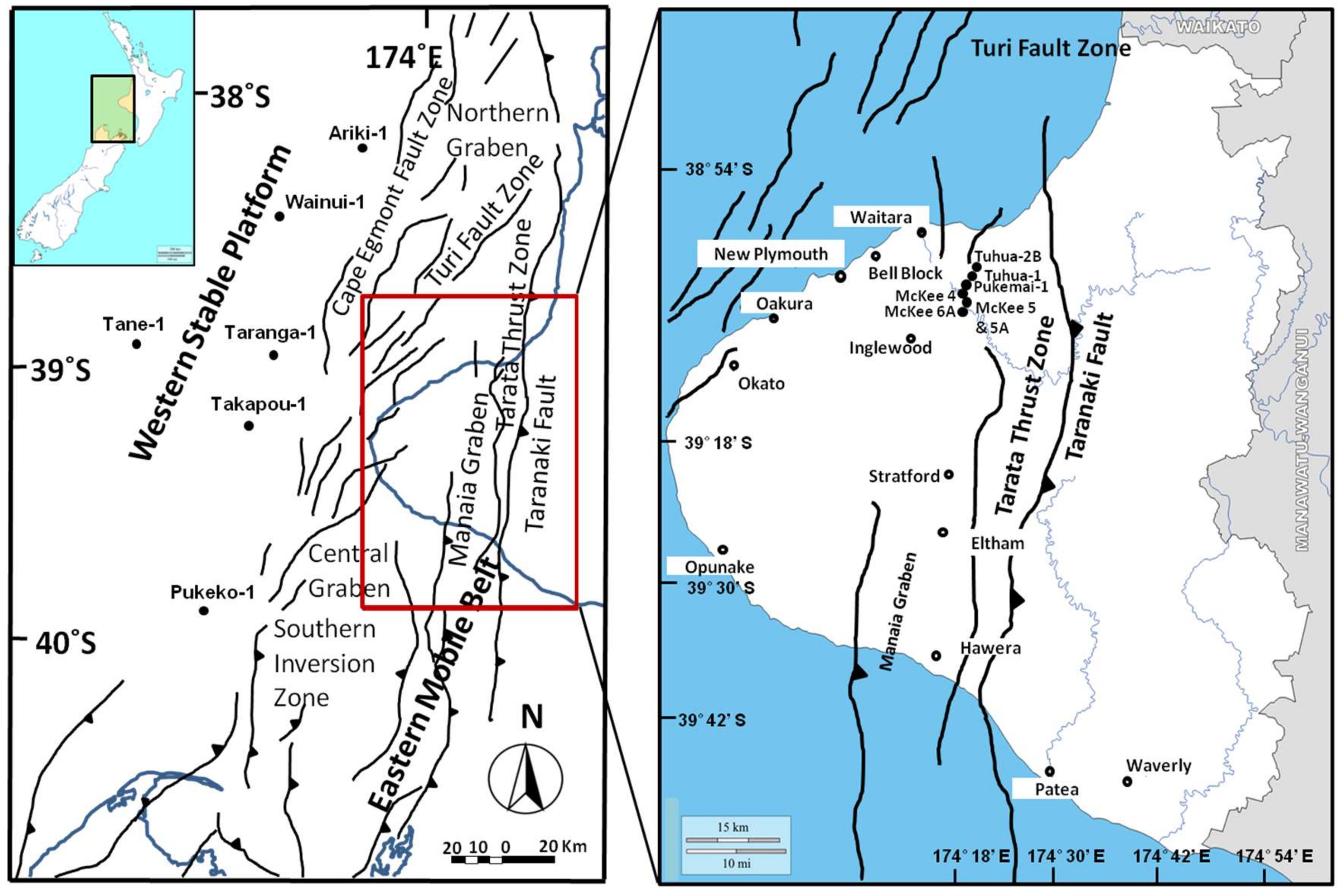

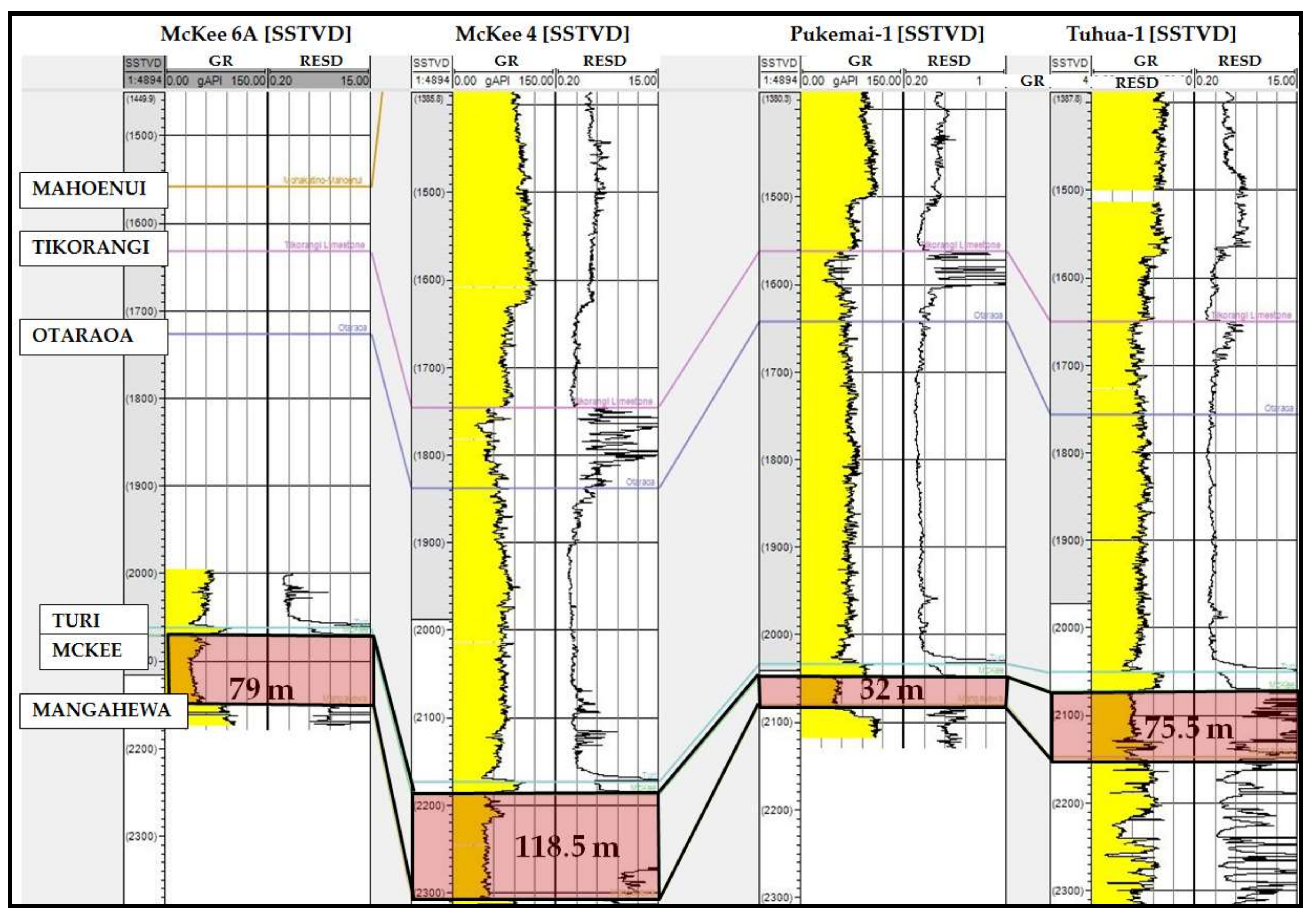
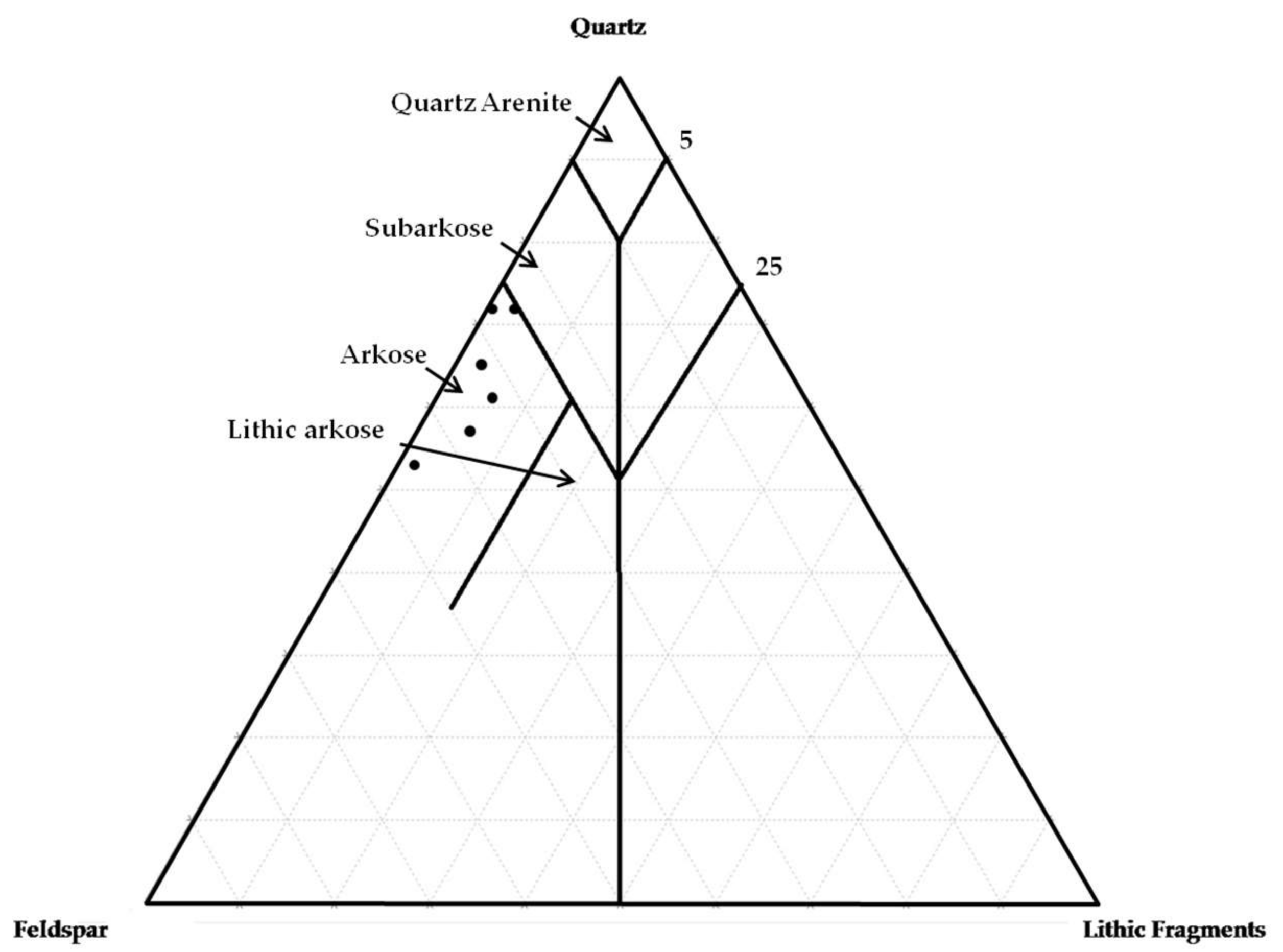
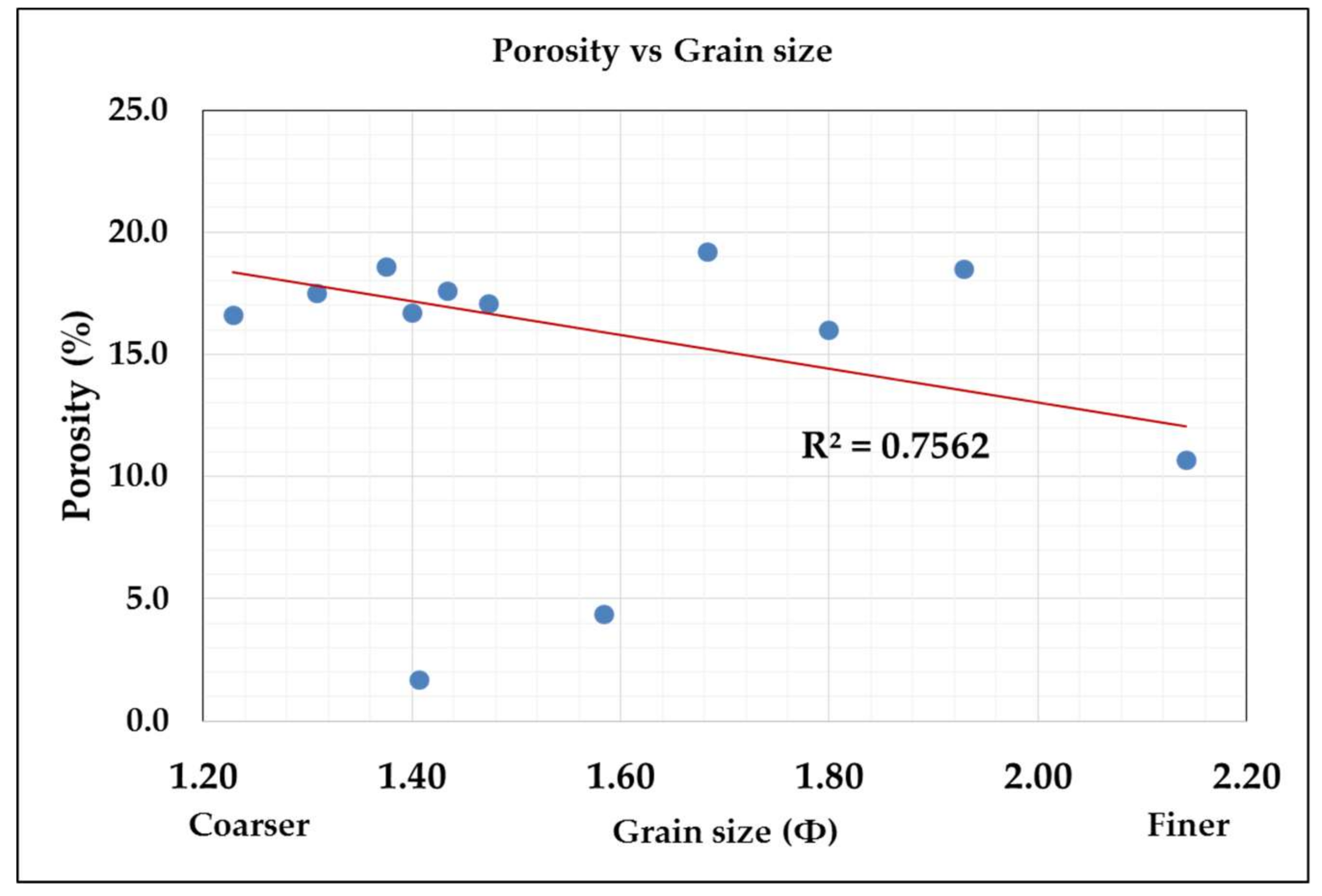
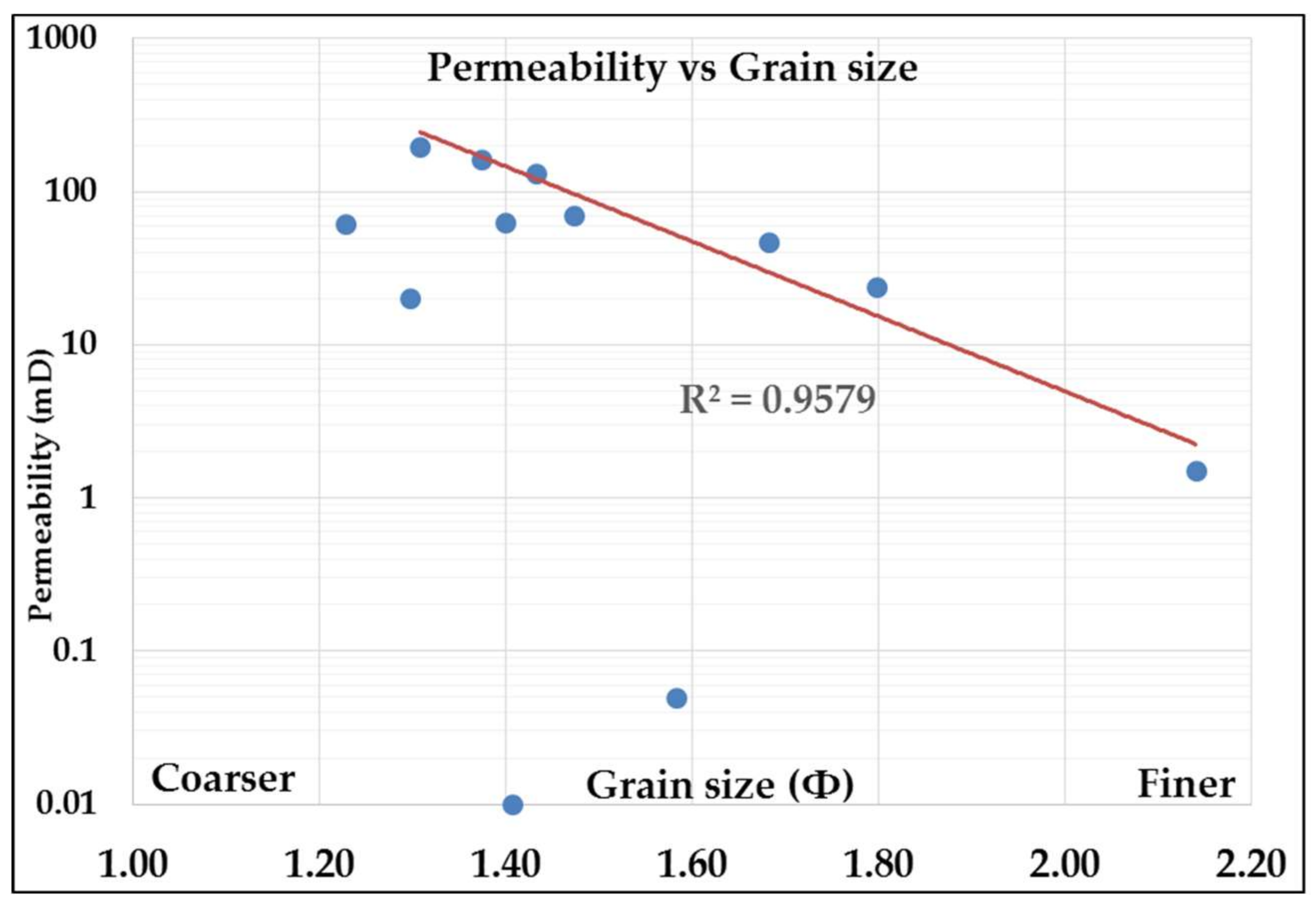
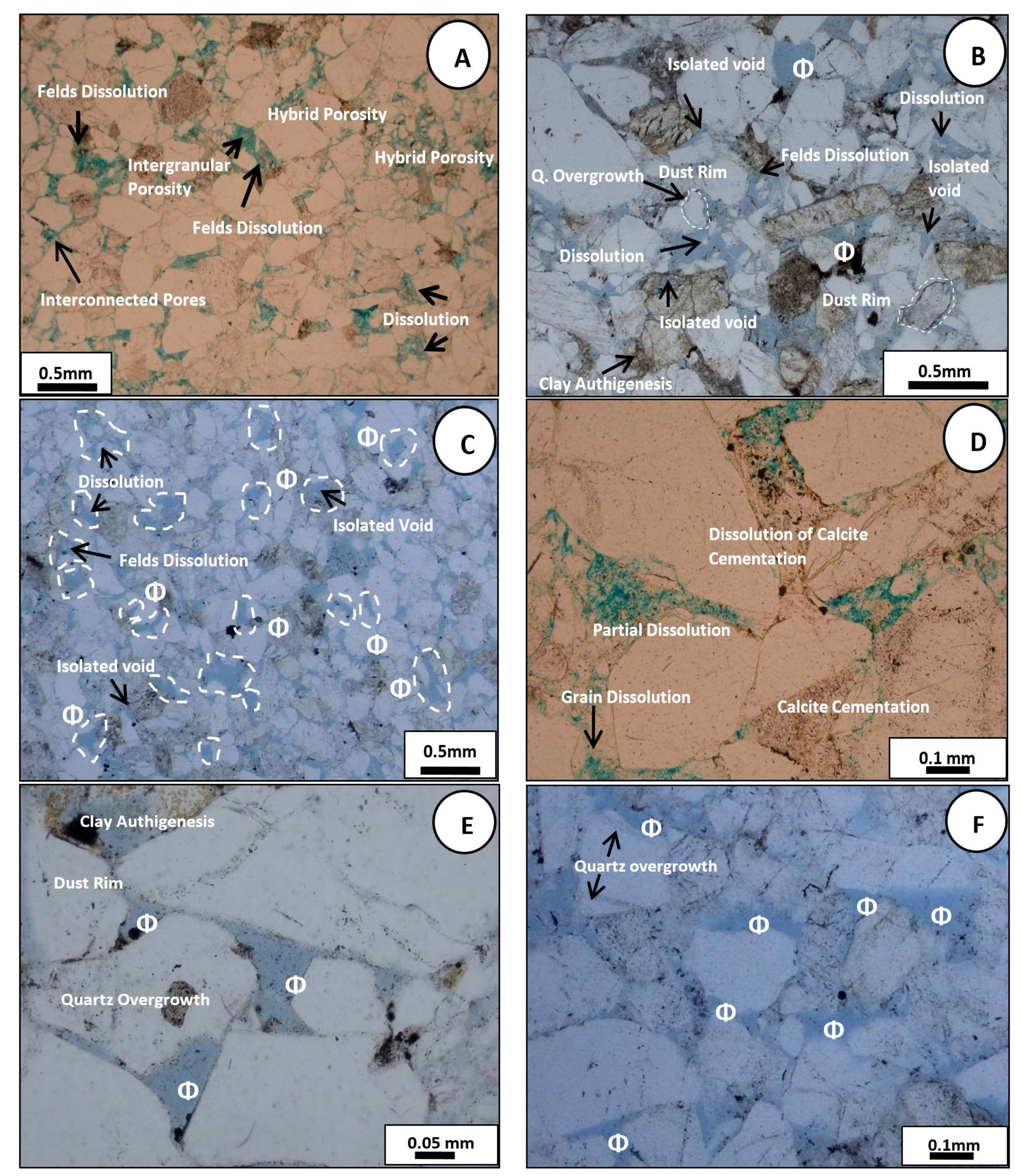

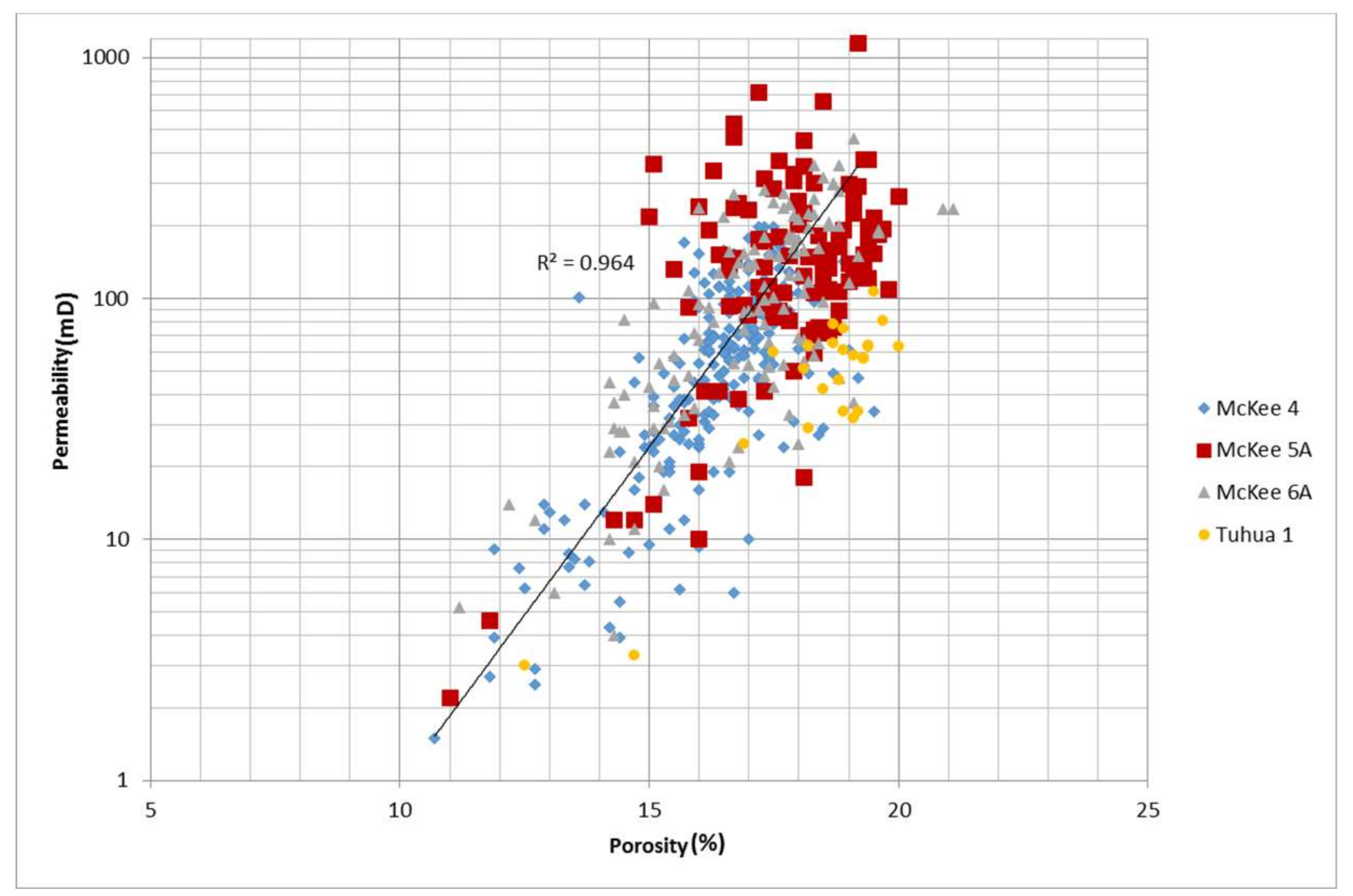

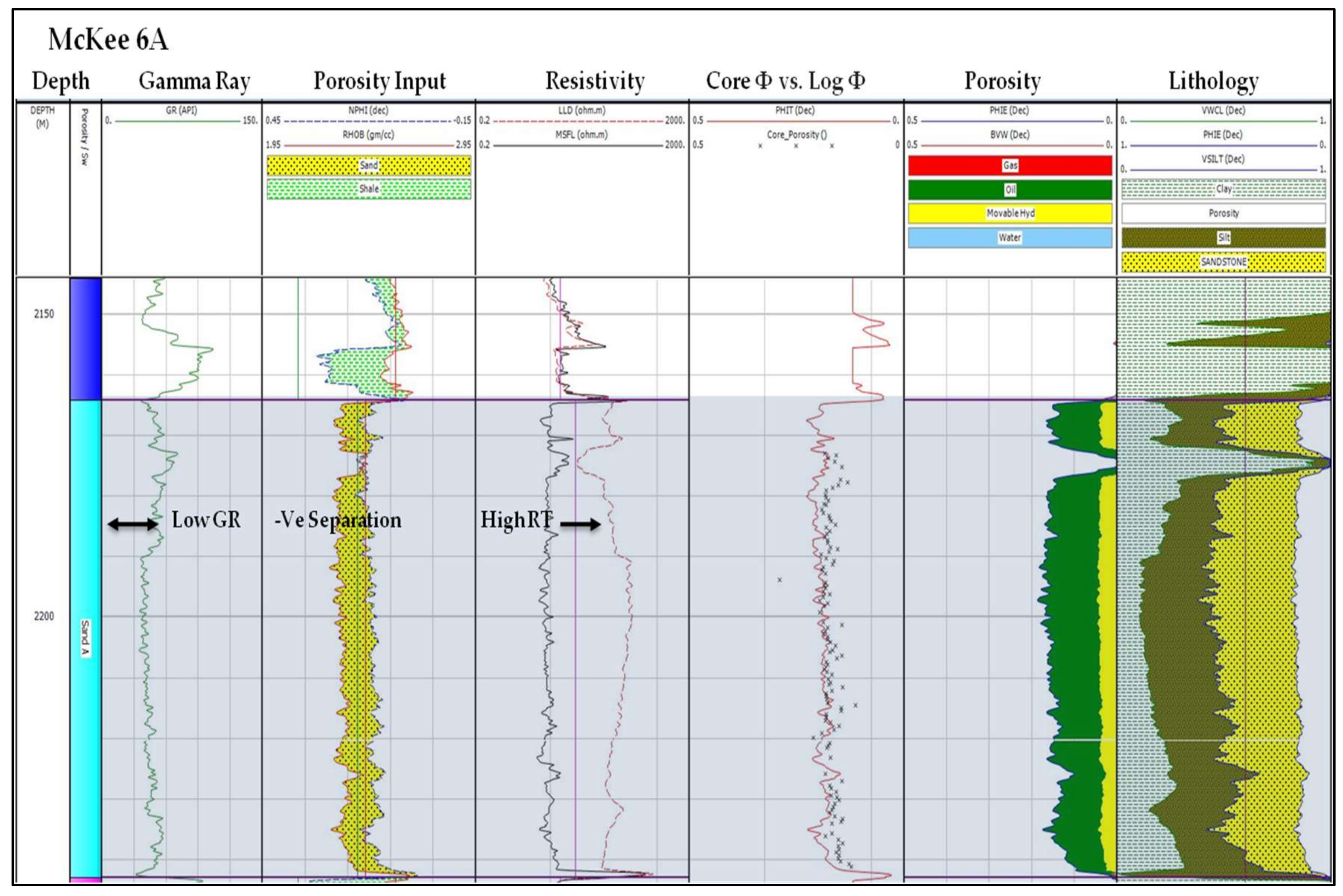
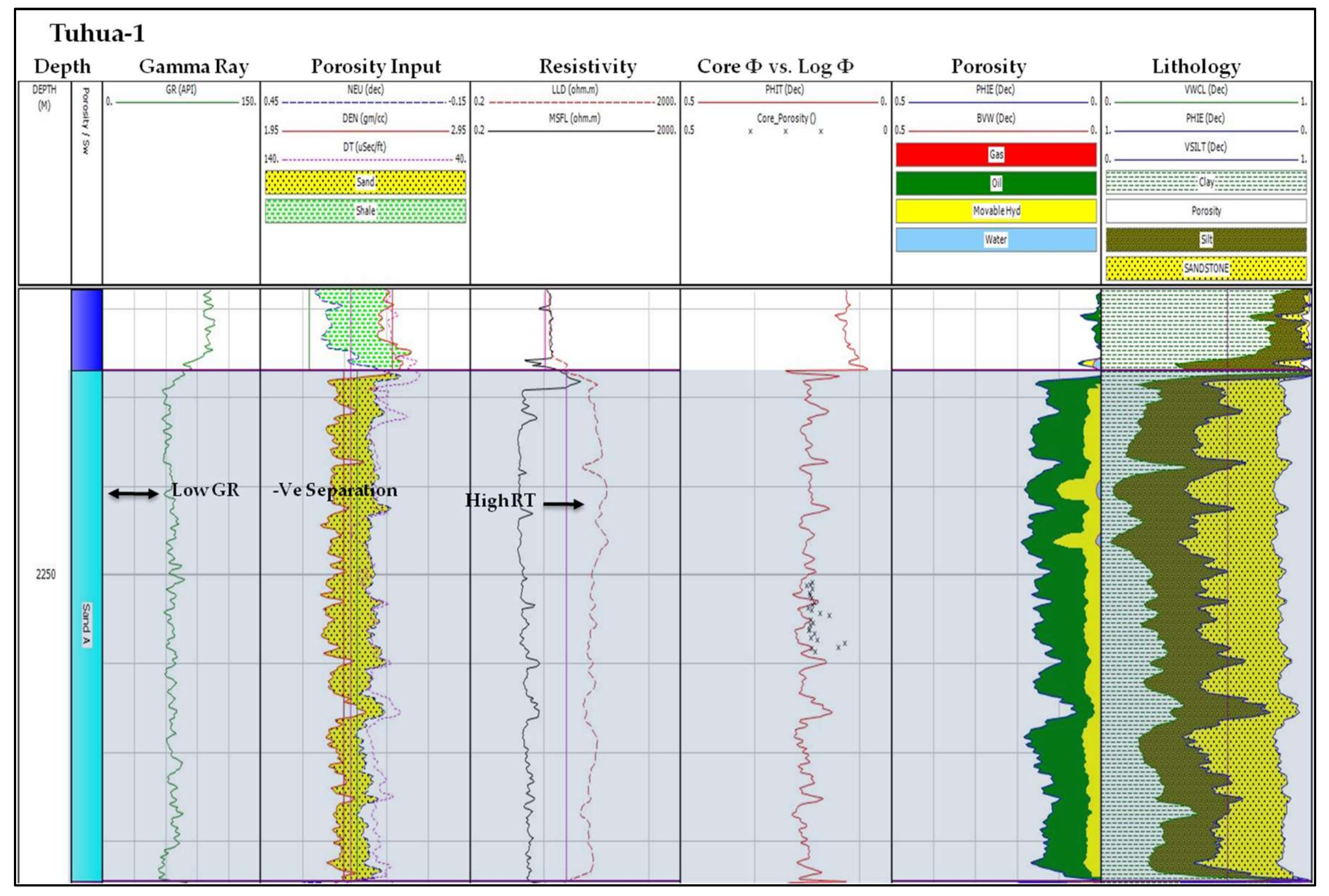
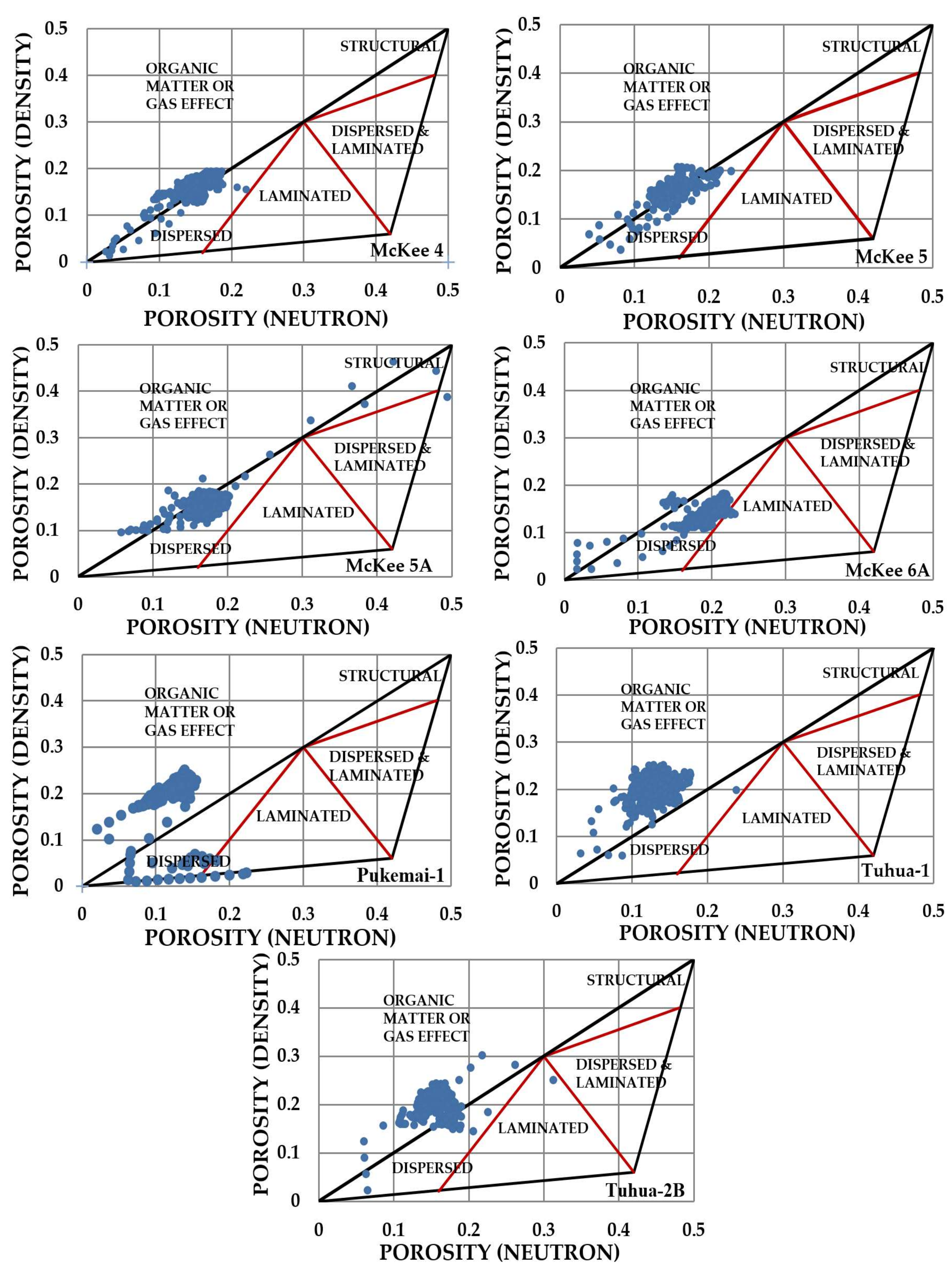
| Well | Depth (m) | Figure No. | Description |
|---|---|---|---|
| McKee 4 | 2355 | 6A | Lower magnification of clean, medium-grained, well-sorted sandstone. Presence of dissolution within the sample creating hybrid porosity. |
| McKee 4 | 2355 | 6D | Moderate magnification of clean, medium-grained sandstone with signs of dissolution and cementation. |
| McKee 4 | 2463 | 7E | Moderate magnification of heavily cemented medium-grained sandstone. |
| McKee 5A | 2328 | 7A | Low magnification of variably argillaceous, medium-grained well-sorted sandstone. Highly quartzose sample with visible pores present only where labiles/matrix are absent. |
| McKee 5A | 2328 | 7B | Moderate magnification of variably argillaceous, medium-grained sandstone showing poor interconnected pores. |
| McKee 6A | 2173.25 | 6B | Low magnification of medium-grained, moderately sorted sandstone. Sample is mostly quartz with subordinate feldspar. |
| McKee 6A | 2173.25 | 6E | High magnification of medium-grained, moderately well-sorted sandstone, showing intergranular pores. |
| McKee 6A | 2184.8 | 7F | Low magnification of medium-grained, moderately well sorted sandstone. Sample is mostly quartz with subordinate feldspar and rare lithics. |
| McKee 6A | 2217 | 7C | Low magnification of medium-grained, well sorted sandstone. Sample is mostly quartz with subordinate feldspar. Pores moderately common and fairly well interconnected. |
| McKee 6A | 2240.25 | 7D | High magnification of medium-grained moderately well-sorted sandstone. Sample shows quartz overgrowth and partial alteration of grain. |
| Tuhua-1 | 2256.33 | 6C | Low magnification of medium-grained, well-sorted sandstone. Sample is mostly quartz with feldspar. |
| Tuhua-1 | 2256.33 | 6F | Moderate magnification of clean, medium-grained, well-sorted sandstone with presence of quartz overgrowth. |
| Well Name | Gross Thickness | Net Reservoir (m) | Net Pay (m) | Avg. Ø (%) | Avg. Vcl (%) | Avg. Sw (%) | Avg. Shc (%) |
|---|---|---|---|---|---|---|---|
| McKee 4 | 114.61 | 101.54 (88.6%) | 60.2 (52.5%) | 13.7 | 20.6 | 29.3 | 70.7 |
| McKee 5 | 42.67 | 18.52 (43.4%) | 8.62 (20.2%) | 11.8 | 34.5 | 38.2 | 61.8 |
| McKee 5A | 62.18 | 40.98 (65.9%) | 40.98 (65.9%) | 14.2 | 25.4 | 18.4 | 81.6 |
| McKee 6A | 79.1 | 73.2 (92.5%) | 73.2 (92.5%) | 15.9 | 14.9 | 13.4 | 86.6 |
| Pukemai-1 | 29.72 | 24.01 (81.4%) | 24.01 (81.4%) | 14.4 | 19.8 | 10.1 | 89.9 |
| Tuhua-1 | 64.62 | 48.7 (75.4%) | 48.7 (75.4%) | 11.9 | 27.8 | 30.3 | 69.7 |
| Tuhua-2B | 70.86 | 66.1 (93.3%) | 66.1 (93.3%) | 15.4 | 20.4 | 16.7 | 83.3 |
© 2018 by the authors. Licensee MDPI, Basel, Switzerland. This article is an open access article distributed under the terms and conditions of the Creative Commons Attribution (CC BY) license (http://creativecommons.org/licenses/by/4.0/).
Share and Cite
Dong, S.P.; Shalaby, M.R.; Islam, M.A. Integrated Reservoir Characterization Study of the McKee Formation, Onshore Taranaki Basin, New Zealand. Geosciences 2018, 8, 105. https://doi.org/10.3390/geosciences8040105
Dong SP, Shalaby MR, Islam MA. Integrated Reservoir Characterization Study of the McKee Formation, Onshore Taranaki Basin, New Zealand. Geosciences. 2018; 8(4):105. https://doi.org/10.3390/geosciences8040105
Chicago/Turabian StyleDong, Swee Poh, Mohamed R. Shalaby, and Md. Aminul Islam. 2018. "Integrated Reservoir Characterization Study of the McKee Formation, Onshore Taranaki Basin, New Zealand" Geosciences 8, no. 4: 105. https://doi.org/10.3390/geosciences8040105




